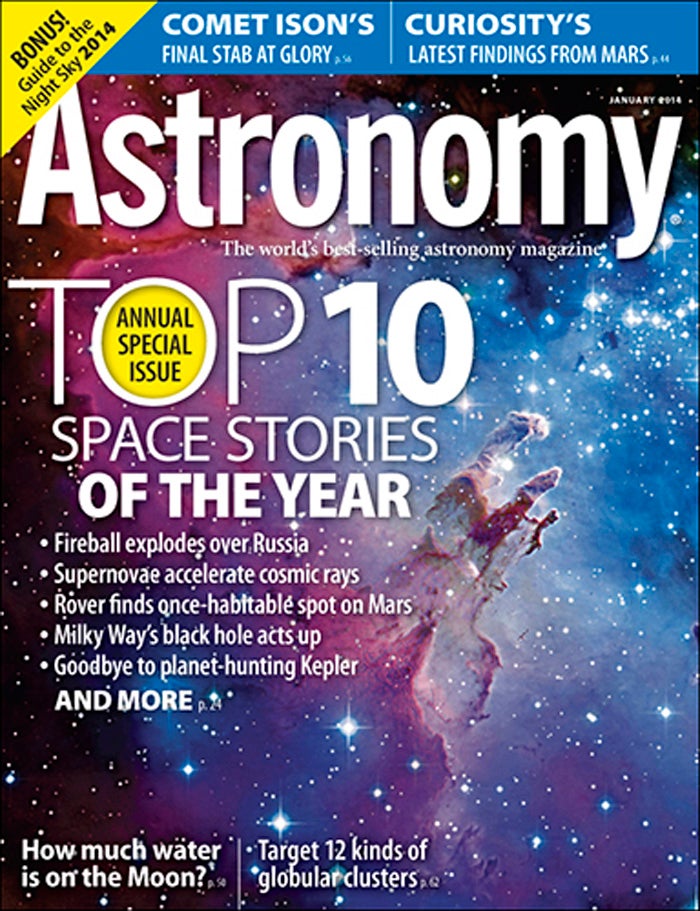
WAUKESHA, Wis. – In 2013, astronomers learned about the origins of the universe’s most powerful particles, watched a spacecraft leave the solar system, lost a planet-hunting telescope, and took the best picture ever of the baby universe. But what was the biggest cosmic story of the year?Astronomy‘s editors ranked the most important stories of the past 12 months, and Associate Editor Liz Kruesi highlights those discoveries in “Top 10 space stories of 2013.”To find out what last year’s number one space story was, pick up the January issue of Astronomy, on newsstands December 3.
“Curiosity’s latest findings from Mars”
NASA’s Mars Curiosity rover landed on the Red Planet on August 6, 2012. In “Curiosity’s latest findings from Mars,” Associate Editor Sarah Scoles digs into what the beloved robot has been up to since then. Without necessitating a “spoiler alert,” we can say it’s been drilling, digging, and scooping up a storm in its quest to map Mars’ past habitability and waterways.
“How much water is on the Moon?”
Astronomers know for sure that water ice exists on the Moon, but the depth and breadth of that ice remain a bit mysterious. In “How much water is on the Moon?” Robert Zimmerman takes a close look at the evidence that probes, landers, samples, and orbiters have sent back to Earth, trying to determine whether the supply is plentiful and accessible enough for hypothetical future colonists.
“Target 12 kinds of globular clusters”
Just because globular clusters are all spherical groups of stars doesn’t mean they’re all the same. In “Target 12 kinds of globular clusters,” astroimager Rod Pommier helps you distinguish the dozen cluster types that astronomers Harlow Shapley and Helen Sawyer devised nearly a century ago.
January sky events visible without optical aid
- January 3 – The Quadrantid meteor shower peaks.
- January 5 – Jupiter reaches its 2014 peak, shining at magnitude –2.7.
- Jan 14/15 – The Moon passes 5° south of Jupiter.
- Jan 22/23 – The Moon passes 4° south of Mars.
- Jan 28 – The Moon and Venus meet in the evening sky.
Also in the January 2014 Astronomy
- Bonus insert: “Astronomy‘s Guide to the Night Sky” – In this supplement, you’ll find charts, maps, and dates for all of 2014’s four seasons. Whether you want to know when the Moon will be full in January or when Deneb transits in October, this four-page insert has the information you need.
- “The Sky this Month” – Exclusive star charts will guide you through January’s night sky.
- The January issue of Astronomy also includes Astro News, Ask Astro, Snapshot, Breakthrough, Bob Berman’s Strange Universe, Stephen James O’Meara’s Secret Sky, Glenn Chaple’s Observing Basics, Tony Hallas’ Cosmic Imaging, Erika Rix’s Astro Sketching, Cosmic World, Letters, Web Talk, New Products, Reader Gallery, and Final Frontier.
Astronomy offers you the most exciting, visually stunning, thorough, and timely coverage of the heavens above. Each monthly issue includes expert science reporting, vivid color photography, complete sky-event coverage, spot-on observing tips, informative equipment reviews, and more. All of this comes in an easy-to-understand user-friendly style that’s perfect for astronomers at any level. Contact Astronomy, the world’s best-selling astronomy magazine, at 262.796.8776 or email editor@astronomy.com.









